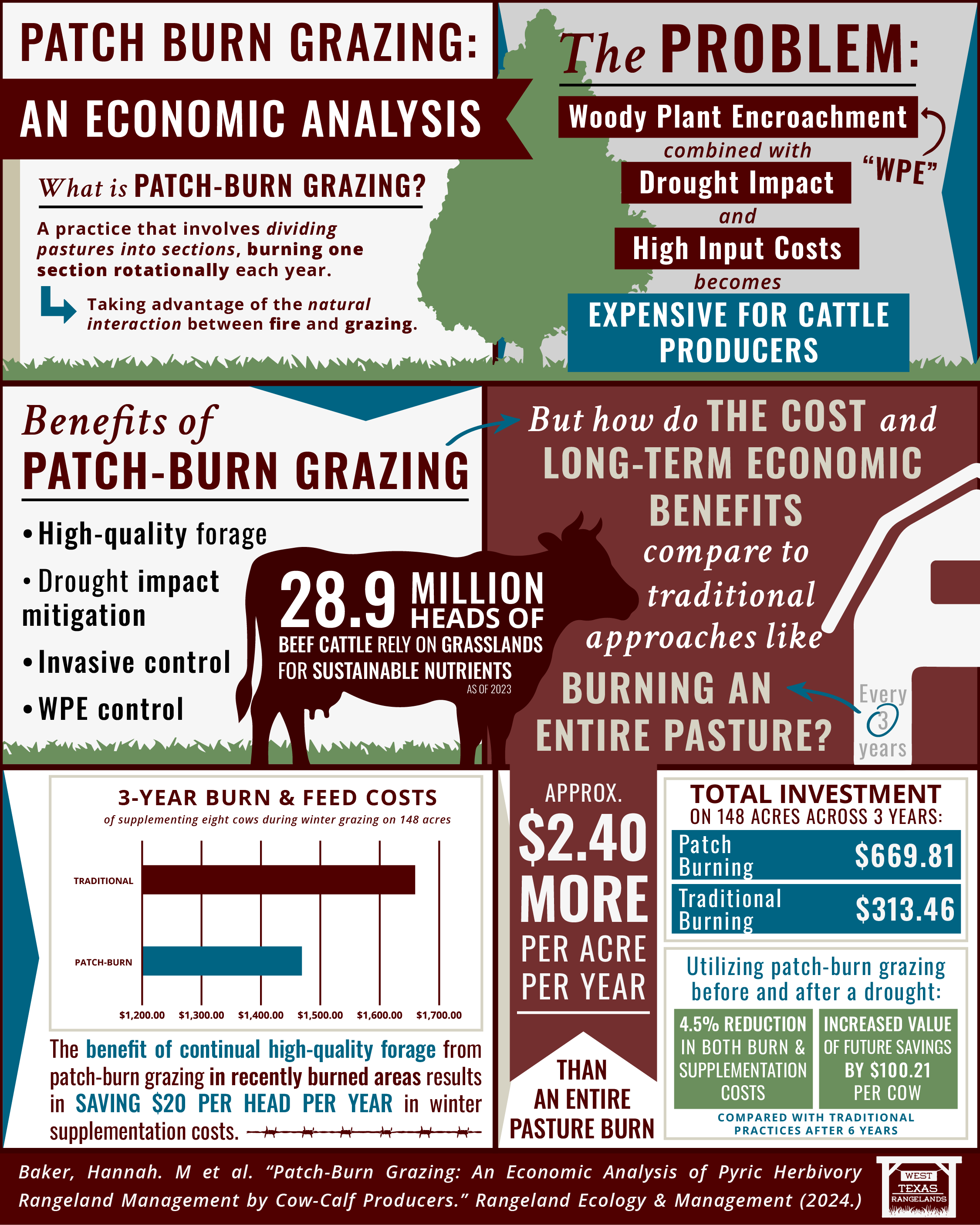 Patch-burn grazing is a practice that requires an understanding of the interaction of fire and grazing (pyric herbivory) (for more information check out www.theprairieproject.org). It divides a pasture into pieces/patches, with one burn rotationally each year. It helps control woody plant encroachment and provides high-quality forages. Despite these known benefits, the adoption of this practice by ranchers has been slow and limited. This study focused on the benefits of patch-burn grazing by estimating the costs and long-term economic benefits. Additionally, researchers compared patch-burning to traditional applications of prescribed fire burning fenceline to fenceline or an entire pasture at once with a 3-year fire return interval.
Patch-burn grazing is a practice that requires an understanding of the interaction of fire and grazing (pyric herbivory) (for more information check out www.theprairieproject.org). It divides a pasture into pieces/patches, with one burn rotationally each year. It helps control woody plant encroachment and provides high-quality forages. Despite these known benefits, the adoption of this practice by ranchers has been slow and limited. This study focused on the benefits of patch-burn grazing by estimating the costs and long-term economic benefits. Additionally, researchers compared patch-burning to traditional applications of prescribed fire burning fenceline to fenceline or an entire pasture at once with a 3-year fire return interval.
The prescribed fire costs were estimated using data from a 2021 prescribed fire survey from the Natural Resource Ecology and Management Department at Oklahoma State University. A dataset was built to estimate feed cost using a 2002-2006 study from Oklahoma State University’s Range Research Station. The potential drought impact mitigation was estimated from historical rainfall, drought severity, and range productivity.
The comparison included a 3-year prescribed fire return interval and feed costs with supplementing 8 cows during winter grazing on 148-acres. The cost to do this traditionally, burning the whole pasture every 3 years, was over $1,600 in total burn and feed costs after 3 yr of supplementing eight cows during the winter grazing 148-acres of native forage. This figure does not include a drought year. A 3-yr time frame is utilized to represent a full burn rotation.
The cost to implement the patch-burn practice was estimated around $1,400 in total burn and feed costs on the 148-acres. The benefit of continual high-quality forage from patch-burn grazing in recently burned areas resulted in saving $20 per head per year in winter supplementation costs.
The utilization of prescribed fire through patch-burn grazing by burning two patches per year provides continual access to high- quality forages for cattle. Burning twice a year (spring and fall) with an optimal stocking rate allows cattle to take advantage of high crude protein levels in recently burned areas and stockpiled forage in unburned areas to create a favorable heterogeneous land- scape. This results in a reduction of winter feed costs by approximately $20 per head per year, with all other costs remaining constant. Compared with traditional burning, total burn costs and feed costs are 10% lower when using patch-burn grazing after a full 3-yr burn rotation for both practices. The future value of these savings, based on the 2021 interest rate, after 6 yr (two full burn rotations) is just over $120 per cow, based on the optimal stocking rate of eight cow–calf pairs continuously grazing 148-acres of native forage.
For more information and the full study, be sure to check it out here!